Beekeeping with copies of ancient vertical cells

Based on the ancient hives of Isthmia
The research of ancient Greek beekeeping is based almost exclusively on archaeological findings, since the ancient secretariat, both Greek and Latin, does not provide us with essential information about the types of hives used in ancient Greece and how to practice beekeeping with them.
Latin writers of course, such as Varron, Virgil, Corumellas, Pliny the Elder, Aelianos, Pseudo-Koidilianos and Palladium, refer to the beekeeping of their time, in some cases (Varron and especially Corumellas) in detail.
It seems, however, that what they write does not concern beekeeping as it was practiced in Greece (note 1).
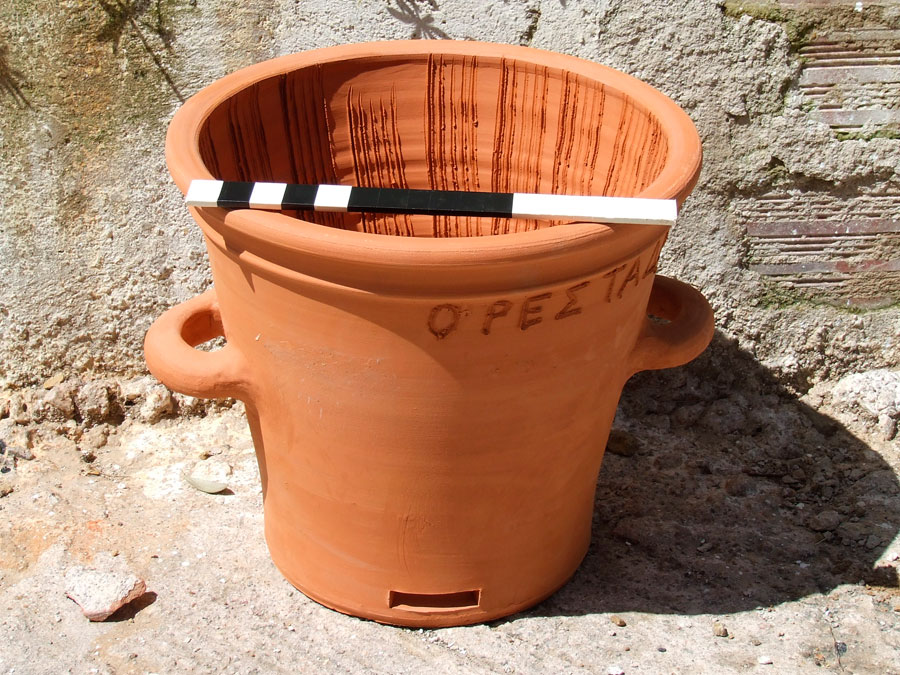
Pict. 1. Copy of the "Orestiada" hive.
The clay cells that the archaeological hoe brought to light belong to two main types, the horizontal and the vertical. The way beekeeping is practiced with horizontal clay hives is well known in detail, since similar hives were until recently in use in many islands of the southern Aegean. Perhaps the only point that needs to be investigated with regard to these horizontal cells is the way in which the extremely small, compared to the corresponding traditional, extensions (expansion rings) for which it is believed that they were used for the production of "smokeless" honeymoons (note 2).
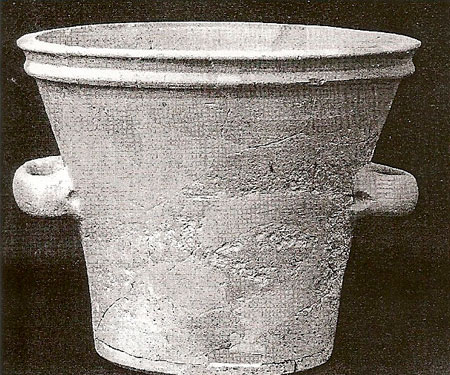
Pict. 2. The Hive "Orestiada" (photo by V.R. Anderson-Stojanovic /
J.E. Jones, «Ancient beehives from Isthmia», Hesperia 4/71, 2002).
Otherwise things are in terms of vertical clay cells. Cells of this type, which date back to the Hellenistic and Roman periods, have come to light in Isthmia (note 3), four have even been restored to their original form. Fragments of clay cells, probably of the Hellenistic period, which appear to belong to the same type were recently found in Agathonisi (note 4). The same type of hive probably includes certain parts of vessels from Chios (note 5), Attica (note 6), and Delos (note 7), dating from the Archaic to the Hellenistic period.

Pict. 3. Placement of flocks in the "Orestiada" hive.
The literature usually does not mention how beekeeping is practiced with ancient vertical cells (note 8). Where indicated, they are either considered 'mobile nest' cells (point 9) or there is talk of the possibility that those cells may be a movable honeycomb or perhaps of an intermediate hypothetical stage between the 'mobile nest' cells and those of the movable honeycomb (point 10).
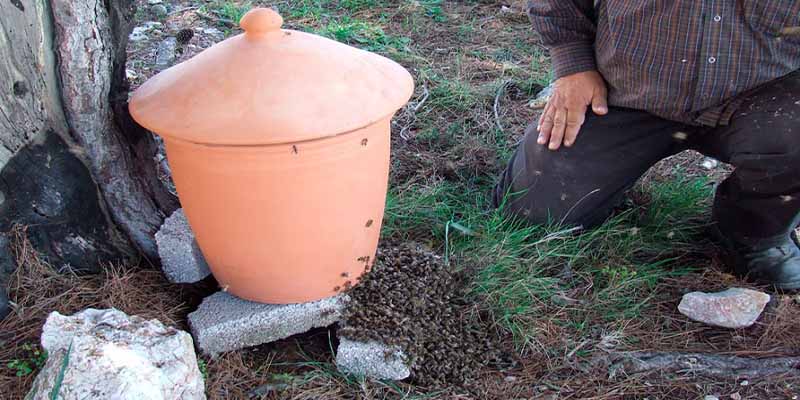
Pict. 4. From the placement of a flock in the copy of the IP 2215 cell.
The function of vertical ancient cells as "mobile nest" cells, i.e. cells that allow the lid to be lifted with the whole nest (the honeycombs and the population of the flock), should in our opinion be rejected. Similar hives have not been recorded anywhere in the world and we believe that with these hives it is not even possible to practice beekeeping in real conditions, because of the many and intractable problems that the beekeeper would face. The cells of the "mobile nest" are, after all, nothing more than a hypothetical intermediate stage of the evolution of the mobile honeycomb cells proposed thirty years ago (point 11) and which assumes that vertical cells are newer than the horizontal ones from which they someday came.
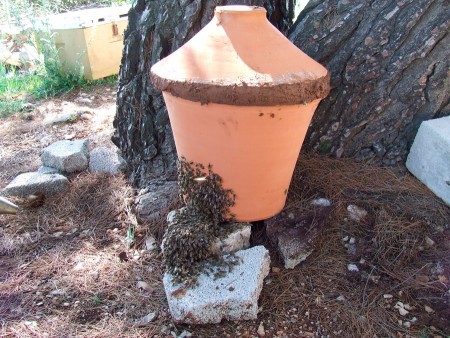
Pict. 5. New smari in the IP 2512 cell.
The individual characteristics of the ancient cells of Isthmia (shape, dimensions, the position of entry of the bees) as well as their ethnographic parallels (point 12) suggest, in our view, that these vertical hives were movable honeycombs, i.e. they used honeycomb forearms at the top, so that bees attach their honeycombs, per one, to each bar, thus allowing a series of manipulations which are otherwise extremely difficult or even impossible. In fact, we believe that nothing else remains to be discovered to confirm this view, unless we expect the wooden honeycombs of the hives to be found, which is of course impossible as long as they are not preserved over time.

Pict. 6. Mobile honeycomb from the copy of "Orestiada".
In order to determine in practice whether these ancient vertical cells could be used successfully as mobile honeycomb cells, we constructed copies of three of the four restored isthmia hives for the purpose of experimental beekeeping with them. In particular, copies of the hive bearing the inscription "ORESTIADA" (IP 586) and two others, which do not bear handles and have the entrance of the bees to the base (IP 2215) and the other to the bottom of the side wall (IP 2512), were constructed. In addition to writing, Maria Gutzamani, an archaeologist and beekeeper, as well as the professional beekeeper from Varnavas Attica Isidoros Tsiminis participated in this experimental beekeeping exercise, with valuable experience for us in mobile honeycomb hives, both in their traditional form and in an "improved" form by him.

Pict. 7. Start the creation of mobile waxes in the IP 2512 cell.
The construction of the copies was entrusted to the experienced potter Panagiotis Foutugio from Kapandriti. In June 2007, under the supervision of archaeologists and with the help of the ceramicist Maria Stefa, the copies were ready (fig. 1). The following spring the hives were transferred to the apiary site. With the exception of the beehive with the inscription, in the others we chose clay lids, without being particularly concerned with their individual characteristics – ancient caps of vertical clay cells have not yet been found. Especially for the "Orestiada" hive (fig. 2) but we used a flat wooden cap, so as not to be considered to have increased its internal volume (although this would be placed above the waxes, which in essence plays no role). This is because the relatively small capacity of the vessel has been an argument for some to consider that it is not a hive (point 13), comparing it with some of the more traditional cells of movable honeycomb that they had in mind (point 14) and ignoring the existence of other, similar, traditional cells with a capacity in some cases even smaller than that of the ancient vessel.

Pict. 8. Mobile honeycombs from IP 2215 in the hands of beekeeper I. Tsimini.
For forearms-waxers, boards about 3.5 cm wide were placed. So was about the width of the honeycombs in the traditional mobile honeycomb cells, which the beekeepers calculated rough using as a measure either the length of the second column of the thumb (as was the case in Crete, point 15) or, more commonly, the sum of the width of the index finger and the middle finger (note 16). The total number of honeycombs per hive turned out to be nine for 'Orestiada' (IP 586), ten for IP 2215 and eleven for IP 2512, which broadly corresponds to that of traditional cells of this type. The traditional clay cells of crete's movable honeycomb, for example, the so-called "brasskia" or "fraskia", basically had ten clay-waxers (note 17).
In the spring of 2008 swarms were placed in the hives (fig. 3, 4 and 5), a project in which they contributed, chasing with us aphids from the wider region, the beekeepers Charalambos Kourkoulis and Mazia Waris. We only had to wait a few days to find out how the bees began to build their honeycombs by attaching them each to the honeycomb bar, creating movable honeycombs (fig. 6).
In the spring of the following year (2010) the experiment was repeated in another area of Kapandriti, not because something remained to be proven, but now for reasons of further observation, experience in beekeeping with mobile honeycombs of the participants and, in a way, pleasant occupation. Of course, bees have again created movable honeycombs (fig. 7 and 8).
In conclusion, the experimental beekeeping exercise with the copies of the vertical cells of Isthmia concludes that these hives could easily and successfully be used as cells of movable honeycomb, just as we believe they were in antiquity.
Giorgos Mavrofrydis, Archaeologist, archaiologia.gr



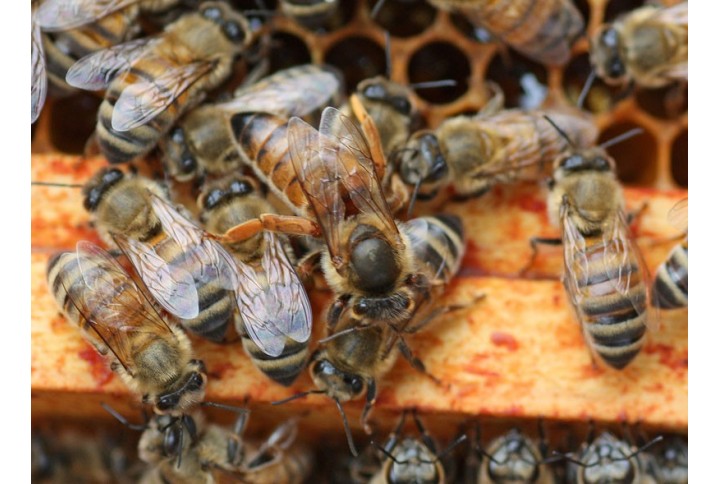


Comments
No comment at this time!
Leave your comment